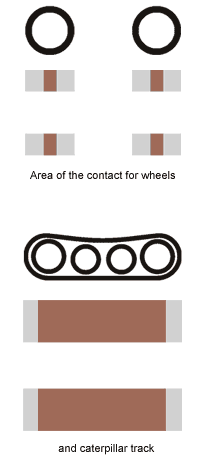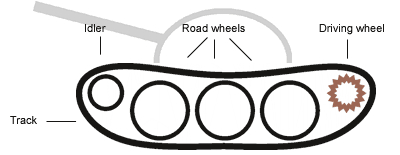Basics

The main advantage of the track over the wheels is that it can distribute a very large force over a large area. That means that instead of applying all the force on little area where wheels touch the ground, it applies it over the whole area of the track.
In physics terms it can be expressed as P = F / A
where P is pressure, F is force and A is area.
Less force applied to every square meter means that it's harder for the heavy vehicle to sink into the ground. Another benefit of the tracks is that large area of contact allows to have a very good traction with the ground. That is why tracks are used for mission critical jobs, including military use and high cost operations, such as excavations and space rocket movements.
Drawbacks
Even though caterpillar tracks provide very good cross-country ability, they have its drawbacks. Because of the weight and the construction of tracks speed of the vehicle is limited in comparison to the wheeled machines. The fastest tanks can only go with the speed of 60-70 mph. Also extensive use of the tracked vehicle is hard on the engine and it needs to go through frequent maintenance.
Uses of the track
The main uses include various kinds of tractors and military tanks. Since everyone knows what tank is, it would be easy to illustrate how its track works.
In any tank there is a set of road wheels, most of them are covered in rubber and resemble ones of a car. Their basic purpose is to support the weight of the vehicle, same as in any other car. Even though it is not the case on most of the modern tanks, in the early days, tracks could be removed and tank would operate as a wheeled vehicle. However rubber tires are still used since they significantly reduces wear on the tracks.

Use of the caterpillar track
A couple of driving wheels are usually the only ones that are powered and they set the tank in motion. They have a set of spikes which go into the track and move it, much like a bicycle chain. All other wheels simply roll on the caterpillar track. Idler located exactly on the opposite side of the driving wheel, but it is not powered.